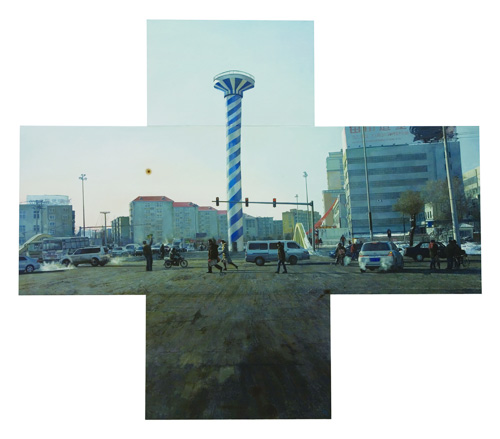|
 |
|
Morning Stool by Li Dafang |
On June 15, a group of Chinese oil painters gathered in the National Art Museum of China with their artwork on display at two exhibitions—"In Time: 2012" Chinese Oil Painting Biennale (the Biennale) and the China Youth Oil Painting Exhibition (CYOPE).
These two exhibitions were said to be the largest exhibitions of their kind in recent years. The paintings displayed various styles and showed the different ways in which Chinese oil painters approach oil painting.
"Since the 1990s, Chinese oil painting has competed with other genres like contemporary video, installation, and performance arts," said Zhang Qing, curator of the Biennale. "We aim to examine, research, and discuss contemporary Chinese oil painting and other art forms through the Biennale."
The Biennale presented 158 works from 32 painters and the CYOPE showcased 143 paintings. Each painter expressed their vision of the theme, "In Time," and their understanding of oil painting as an art form.
"The Biennale highlights the respect for oil painting's modernity," said Xu Jiang, Chairman of China Oil Painting Society and President of the China Academy of Art. "Modernity here is not a temporal concept. It is the time in which things happen, in which current events awaken."
Recording reality
"Oil painting for me is just a form of art; it is the content that matters," said Zhang Lujiang, a professor at the Central Academy of Fine Arts. In 2011, Zhang went to Guangzhou in south China's Guangdong Province and spent 35 days in an on-site study of Xian Village, an urban village surrounded by high-rises within the Pearl River New Town.
"In my painting, I didn't exaggerate what I saw," said Zhang about a painting entitled King Land, a term that refers to land that has been bid out at the highest price in the real estate market. The buildings on the "King Land" are typically the most expensive in the city. Zhang's painting shows the sharp contrast between the towering luxury buildings in the area and the shabby low-rise housing units nearby.
"The painting is shrouded in shades of gray and ambiguous aura, reflecting the painter's understanding of anxieties of people in the process of urbanization," said Zhang. "It focuses on the changes in the urban environment and its impact on people's lives, offering an accurate, bird's-eye view of the unique atmosphere of contemporary China caught in the rapid process of urbanization."
Zhang recorded his experience of the on-site study in a documentary film. "I think oil painting itself can be a still documentary," he said. "It is vivid and has its own power."
Li Dafang, a 41-year-old painter, shares a similar perspective with Zhang in his three paintings featured in the exhibition—Morning Stool, Xiao Xia Backpack, and Little Yu's Wooden Tower. The paintings resemble still photographs showing scenes of daily life in the small towns of northeast China. The rough landscapes, tangled thickets, abandoned factories and cityscapes that appear in his works are all distinctly northeastern.
"I focus more on the depiction of objects and human emotion. I hope that my paintings could reveal the universal in the details of daily life," said Li.
The exhibition curator described Li's works of art this way: "Looking at his paintings is like watching a play, which doesn't require much explanation. Honest narrative will do, as people can easily observe through the depiction of forests, machinery, smokestacks, and ladders. His canvases contain a story without a beginning or an end."
The works "go beyond my expectations of oil paintings," said a student surnamed Du from Renmin University of China who went to visit the exhibitions. "They look like works taken by a veteran photographer."
Memory of the old times
Jelly Times, a term coined by Yu Hua to describe her oil paintings at a Shanghai Art Museum exhibition in 2007, has become one of the primary artistic techniques in subsequent years.
| 